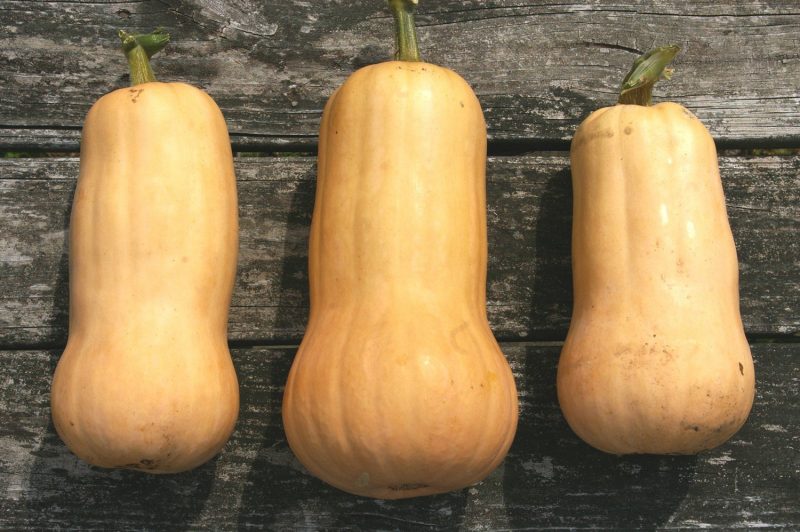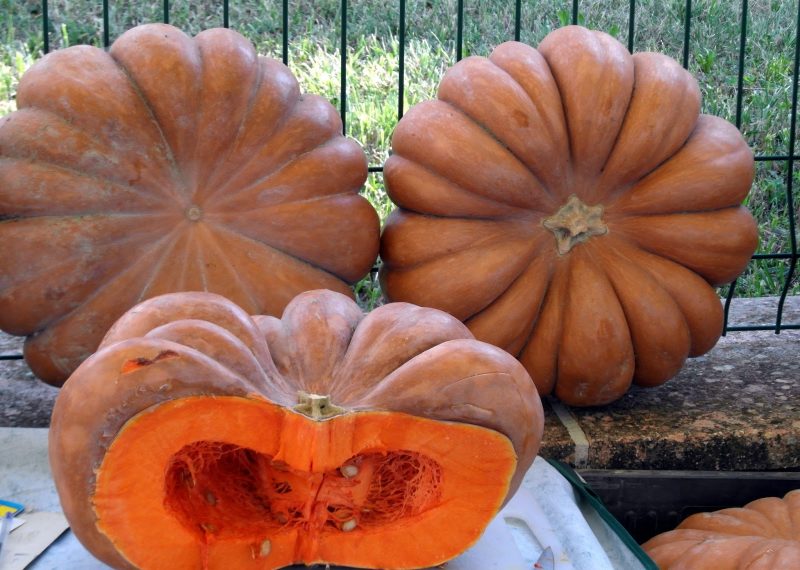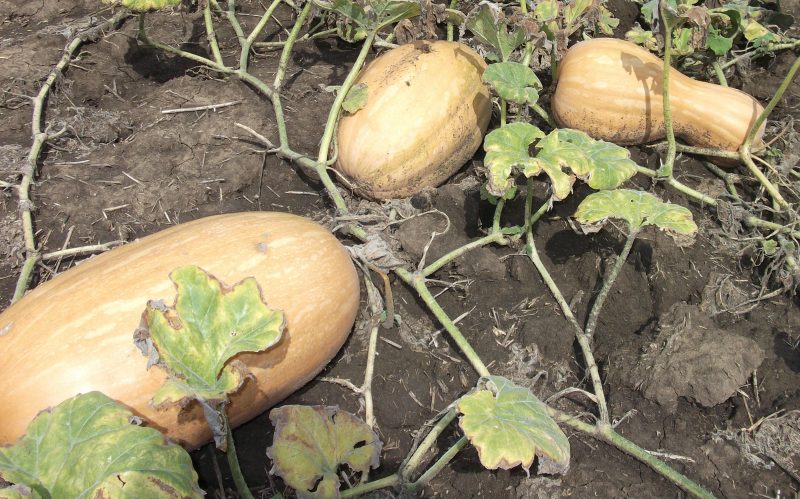Butternut squash is one of the sweetest and most delicious. Pumpkin pulp contains many useful substances - vitamins, mineral salts, and even surpasses apples in iron content. How to choose the right variety and grow a pumpkin will be discussed in the article.
Material Content:
Nutmeg Pumpkin: Variety Description
Growing pumpkins is a rewarding activity, because the culture does not require complicated care. Among the variety of varieties, you can choose pumpkins with different ripening dates, aroma and taste of pulp, fruit size, disease resistance and keeping quality.

Popular nutmeg pumpkin varieties:
- "Geleia." This variety has smooth, dark orange fruits that can be of various shapes (spherical, cylindrical or oval). Fruit weight more than 9 kg.
- "Novelty." The variety has oblong, light orange fruits, which are narrowed in the middle and expand downward. On average, the weight of the fruit is 4 kg. The variety is mid-season, well stored.
- "Muscat." A late-ripening variety, it has oblong, light orange fruits. This pumpkin is characterized by a high content of carotene and is recommended for dietary, baby food and juice preparation.
- "Vitamin". Mid-ripe nutmeg pumpkin, the color of the peel is green. The pulp is orange-red, the weight of ripe fruits is up to 7 kg. The fruits are used in any form, even raw, mixing grated pulp with apple and sugar.
- "Pearl". It has an oblong shape, the peel is orange with green stains. Muscat squash “Pearl” has fruits weighing up to 8 kg, a delicate and fragrant orange flesh.
- "Mirani di Chioggia." The green in pimples fruits of this pumpkin variety can weigh up to 10 kg.They look scary, but have a sweet, fragrant flesh.
If the description of the pumpkin variety contains information that it is of medium or late ripening, it is advisable to grow the plant through seedlings. So that the crop in the beds has time to ripen, the finished seedlings are planted in open ground in May.
The main nuances of growing
Nutmeg pumpkin, the cultivation of which is similar to ordinary varieties, still requires more care and attention. Its fruits will be eaten, so good watering and nutrition are important.

So that the pumpkin does not “fatten”, growing only green stems and leaves, it is necessary to feed it only at the initial stage of seedling development and after the ovaries appear.
In order for the pumpkin to be tasty, it needs potassium.
You can feed the plant with ash. To do this, dissolve in 1 bucket of water 1 or 2 tbsp. ash, insist a day and water the pumpkin. There are potash fertilizers on sale, which can also be used for feeding.
It is advisable to lay wooden planks under the ripening fruits so that they do not begin to rot. Excess lashes must be cut, leaving no more than 3-4 fruits on each shoot, and on dry days it is important not to forget to water.
Planting nutmeg pumpkins in open ground
The seeds of early ripe varieties of nutmeg pumpkin can be sown directly in open ground in early May. Pre-prepare the site and the soil.
Pumpkin can not be grown in the shade - from this it loses in size and taste.
- Pumpkin loves fertile soil, which passes air well.
- You can’t grow it on clay soil that holds water.
- When planting in heavy soil, sand and fertilizers must be added.
Pumpkin seeds are advised to be planted in open ground on a raised bed, as the roots of the plant like warm soil. From autumn, you can fence off planks of earth with boards, cover with foil, adding previously rotted compost, and in the spring plant a pumpkin on such an elevated bed. She will feel great and grow.
How to care for a pumpkin
To get a good pumpkin crop, you need to provide regular watering, nutrition and protection from diseases. It is also important to form the stem by pinching it when it reaches a length of 1.2 m. It is advisable to leave 2 or 3 lateral ones on the central shoot.

Water the pumpkin during lash growth, flowering, and ovary formation. It is especially important to moisten the soil during fruit loading.
Once a week, about 20 or 30 liters of water are poured onto each plant. Around the bushes make a groove and pour water under the root, without spraying it on the leaves.
During the growing season do 1 - 2 top dressing:
- at the time of growth, seedlings make a complete complex fertilizer for gourds;
- the second time they are fed during the appearance of the ovaries.
If a pumpkin is grown from seeds sown in open ground, when several seedlings appear in one hole, they are thinned out. At first, after watering around the bushes, the soil is loosened, weeds are pulled out. When the leaves grow, there will be no weeds and dry earthen crust beneath them.
Breeding
Pumpkin propagated by seeds. They can be collected from ripened fruits that have grown the largest and most delicious, dried and stored until spring. In May, they should be sown in open ground on prepared beds.

When propagated by the seedling method, seeds are sown in 1 - 2 pieces in each pot.
The soil is used loose and fertile. You can mix universal soil purchased in a store with coarse sand.
- Seeds are placed to a depth of about 3 cm, moisten the soil and cover with a bag or glass until seedlings appear.
- Daily air, maintain humidity.
- Sprouted seedlings are placed in a warm, bright place.
- About a month later, seedlings are planted in open ground.
There are a large number of hybrid varieties on sale. If you collect and plant such seeds, the grown pumpkins will not inherit the signs of the parent plant.Therefore, the collection of hybrid varieties must be updated annually by buying seeds in a store.
Pests, diseases and prevention of their occurrence
For pumpkins, viral, fungal and bacterial diseases are dangerous.

- When anthracnose leaves change color and dry, the fruits rot. The diseased plants are destroyed, and the remaining ones are sprayed with a Bordeaux mixture.
- With increased humidity, powdery mildew spots may appear on the leaves. Plants are treated with sulfur-containing fungicides, and with downy mildew - Bordeaux liquid or Fitosporin.
- The future crop is also threatened by pests - gourds and germs. Sprout fly larvae can eat pumpkin sprouts and shoots. Virin-OS bioinsecticide is used for spraying.
Collection and storage of vegetables
Harvest time depends on the pumpkin variety. Early ripening varieties ripen approximately three or three and a half months after seed germination, which occurs in August and early September. But the early pumpkin varieties are not stored for a long time, it is better to put them into processing - preservation, freezing, making juices.

Mid-ripening varieties ripen approximately 4 months after planting. You can harvest the fruits from mid-September to frost.
Late ripening varieties ripen up to 140 days after planting. Harvesting such fruits begins from the end of September until the first frost. They can be stored for a long time in the winter in a dry, cool cellar at temperatures from +3 to + 15 ° C. During storage, their taste only improves.
Gather pumpkin as soon as dahlia flowers begin to darken in the garden, at minus 1 ° C. She can tolerate small frosts. Pumpkin leaves begin to die off before you need to collect the fruits, and you should not hurry much with cleaning. The longer the fruits lie on the bed, the tastier and more they become.












